Differential Geochemical Features of Lacustrine Shale and Mudstone from Triassic Yanchang Formation, Ordos Basin, China: Insights into Their Sedimentary Environments and Organic Matter Enrichment
Abstract
1. Introduction
2. Geological Background
3. Methodology
4. Results
4.1. Total Organic Carbon Content
4.2. Elemental Geochemistry
4.2.1. Major Elements
4.2.2. Trace Elements
4.2.3. Rare Earth Elements
5. Discussion
5.1. Sedimentary Environments Differential Between Shale and Mudstone
5.1.1. Paleoclimate
5.1.2. Paleosalinity
5.1.3. Paleoredox Conditions
5.1.4. Paleowater Depth
5.1.5. Paleoproductivity
5.1.6. Tectonic Setting and Sedimentary Provenance
5.2. Insight for Organic Matter Enrichment
5.2.1. The Main Controlling Factors for Organic Matter Enrichment
5.2.2. The Model of Organic Matter Enrichment
6. Conclusions
Author Contributions
Funding
Data Availability Statement
Conflicts of Interest
References
- Picard, M.D. Classification of fine-grained sedimentary rocks. J. Sediment. Res. 1971, 41, 179–195. [Google Scholar] [CrossRef]
- Peng, J.; Yao, Z.; Yang, Y.M.; Yu, L.D.; Xu, T.Y. Discussion on classification and naming scheme of fine-grained sedimentary rocks. Petrol. Explor. Dev. 2022, 49, 121–132. [Google Scholar] [CrossRef]
- Pang, X.J.; Wang, G.W.; Kuang, L.C.; Lai, J.; Gao, Y.; Zhao, Y.D.; Li, H.B.; Wang, S.; Bao, M.; Liu, S.C.; et al. Prediction of multiscale laminae structure and reservoir quality in fine-grained sedimentary rocks: The Permian Lucaogou Formation in Jimusar Sag, Junggar Basin. Pet. Sci. 2022, 19, 2549–2571. [Google Scholar] [CrossRef]
- Jiao, X.; Liu, Y.Q.; Yang, W.; Zhou, D.W.; Bai, B.; Zhang, T.S.; Zhao, M.R.; Li, Z.X.; Meng, Z.Y.; Yang, Y.Y.; et al. Fine-grained volcanic-hydrothermal sedimentary rocks in Permian Lucaogou Formation, Santanghu Basin, NW China: Implications on hydrocarbon source rocks and accumulation in lacustrine rift basins. Mar. Pet. Geol. 2020, 114, 104201. [Google Scholar] [CrossRef]
- Wang, F.; Chen, R.; Yu, W.; Tian, J.; Liang, X.; Tan, X.; Gong, L. Characteristics of lacustrine deepwater fine-grained lithofacies and source-reservoir combination of tight oil in the triassic chang 7 member in Ordos Basin, China. J. Pet. Sci. Eng. 2021, 202, 108429. [Google Scholar] [CrossRef]
- Pan, X.; Wang, Z.; Li, Q.; Gao, J.; Zhu, L.; Liu, W. Sedimentary environments and mechanism of organic matter enrichment of dark shales with low TOC in the Mesoproterozoic Cuizhuang Formation of the Ordos Basin: Evidence from petrology, organic geochemistry, and major and trace elements. Mar. Pet. Geol. 2020, 122, 104695. [Google Scholar] [CrossRef]
- Yu, W.; Tian, J.; Wang, F.; Liang, Q.; Yang, T.; Kneller, B.; Liang, X. Sedimentary environment and organic matter enrichment of black mudstones from the upper Triassic Chang-7 member in the Ordos Basin, Northern China. J. Asian. Earth. Sci. 2022, 224, 105009. [Google Scholar] [CrossRef]
- Luo, Q.Y.; Goodarzi, F.; Zhong, N.M.; Qiu, N.S.; Wang, X.M.; Suchý, V.; Khan, I.; Zheng, X.W.; Liu, B.; Ardakani, Q.H.; et al. Dispersed organic matter from pre-Devonian marine shales: A review on its composition, origin, evolution, and potential for hydrocarbon prospecting. Earth Sci. Rev. 2024, 261, 105027. [Google Scholar] [CrossRef]
- Adegoke, A.K.; Abdullah, W.H.; Hakimi, M.H.; Yandoka, B.M.S.; Mustapha, K.A.; Aturamu, A.O. Trace elements geochemistry of kerogen in Upper Cretaceous sediments, Chad (Bornu) Basin, northeastern Nigeria: Origin and paleo-redox conditions. J. Afr. Earth Sci. 2014, 100, 675–683. [Google Scholar] [CrossRef]
- Nesbitt, H.; Young, G. Early Proterozoic climates and plate motions inferred from major element chemistry of lutites. Nature 1982, 299, 715–717. [Google Scholar] [CrossRef]
- Cao, Y.; Song, H.; Algeo, T.J.; Chu, D.; Du, Y.; Tian, L.; Wang, Y.; Tong, J. Intensified chemical weathering during the Permian-Triassic transition recorded in terrestrial and marine successions. Palaeogeogr. Palaeoclimatol. Palaeoecol. 2019, 519, 166–177. [Google Scholar] [CrossRef]
- Wei, W.E.I.; Algeo, T.J. Elemental proxies for paleosalinity analysis of ancient shales and mudrocks. Geochim. Cosmochim. Acta 2020, 287, 341–366. [Google Scholar] [CrossRef]
- Xiao, B.; Liu, S.; Li, Z.; Ran, B.; Ye, Y.; Yang, D.; Li, J. Geochemical characteristics of marine shale in the Wufeng Formation–Longmaxi Formation in the northern Sichuan Basin, South China and its implications for depositional controls on organic matter. J. Pet. Sci. Eng. 2021, 203, 108618. [Google Scholar] [CrossRef]
- Syaeful, H.; Bakhri, S.; Muljana, B.; Sumaryanto, A.; Sukadana, I.G.; Pratama, H.A.; Muhammad, A.G.; Indrastomo, F.D.; Ciputra, R.C.; Widodo, S.; et al. Elemental Geochemistry on Paleoenvironment Reconstruction: Proxies on Miocene-Pliocene of Marine to Fluvial Sediment in Serpong, Banten, Indonesia. Geosciences 2024, 14, 189. [Google Scholar] [CrossRef]
- Li, Q.; Wu, S.; Xia, D.; You, X.; Zhang, H.; Lu, H. Major and trace element geochemistry of the lacustrine organic-rich shales from the Upper Triassic Chang 7 Member in the southwestern Ordos Basin, China: Implications for paleoenvironment and organic matter accumulation. Mar. Pet. Geol. 2020, 111, 852–867. [Google Scholar] [CrossRef]
- Al-Taee, N.T.; Al-Juboury, A.I.; Ghafor, I.M.; Zanoni, G.; Rowe, H. Depositional environment of the late Paleocene-early Eocene Sinjar Formation, Iraq: Implications from facies analysis, mineralogical and geochemical proxies. Heliyon 2024, 10, e25657. [Google Scholar] [CrossRef]
- Hou, L.; Pang, Z.; Luo, X.; Lin, S. Sedimentary features of the gravity flow influenced shale deposit: A case study of Chang 7 member in the Ordos Basin, China. Mar. Pet. Geol. 2023, 153, 106277. [Google Scholar] [CrossRef]
- Cui, J.; Zhang, Z.; Liu, J.; Liu, G.; Huang, X.; Qi, Y.; Mao, Z.; Li, Y. Hydrocarbon generation and expulsion quantification and contribution of multiple source rocks to hydrocarbon accumulation in Yanchang Formation, Ordos Basin, China. J. Nat. Gas Geosci. 2021, 6, 375–391. [Google Scholar] [CrossRef]
- Jiang, Y.; Gong, H.J.; Pu, R.H. Geochemical characteristics of source rocks in the Chang 9–Chang 7 members and their correlation with the tight oil sources of Chang 8 member in the Ganquan-Fuxian area, Ordos Basin. Sediment. Geol. Tethyan Geol. 2024, 44, 656–670, (In Chinese with English abstract). [Google Scholar] [CrossRef]
- Li, D.; Shi, Q.; Mi, N.; Xu, Y.; Wang, X.; Tao, W. The type, origin and preservation of organic matter of the fine-grain sediments in Triassic Yanhe Profile, Ordos Basin, and their relation to paleoenvironment condition. J. Pet. Sci. Eng. 2020, 188, 106875. [Google Scholar] [CrossRef]
- Fu, J.H.; Li, S.X.; Xu, L.M.; Niu, X.B. Paleo-sedimentary environmental restoration and its significance of Chang 7 Member of Triassic Yanchang Formation in Ordos Basin, NW China. Petrol. Explor. Dev. 2018, 45, 998–1008. [Google Scholar] [CrossRef]
- Zheng, R.; Zeng, W.; Li, Z.; Chen, X.; Man, K.; Zhang, Z.; Wang, G.; Shi, S. Differential enrichment mechanisms of organic matter in the Chang 7 Member mudstone and shale in Ordos Basin, China: Constraints from organic geochemistry and element geochemistry. Palaeogeogr. Palaeoclimatol. Palaeoecol. 2022, 601, 111126. [Google Scholar] [CrossRef]
- Qiao, J.; Baniasad, A.; Zieger, L.; Zhang, C.; Luo, Q.; Littke, R. Paleo-depositional environment, origin and characteristics of organic matter of the Triassic Chang 7 Member of the Yanchang Formation throughout the mid-western part of the Ordos Basin, China. Int. J. Coal Geol. 2021, 237, 103636. [Google Scholar] [CrossRef]
- Zhang, B.; Mao, Z.; Zhang, Z.; Yuan, Y.; Chen, X.; Shi, Y.; Liu, G.; Shao, X. Black shale formation environment and its control on shale oil enrichment in Triassic Chang 7 Member, Ordos Basin, NW China. Petrol. Explor. Dev. 2021, 48, 1304–1314. [Google Scholar] [CrossRef]
- Yuan, W.; Liu, G.; Zhou, X.; Xu, L.; Li, C. Palaeoproductivity and organic matter accumulation during the deposition of the Chang 7 organic-rich shale of the Upper Triassic Yanchang Formation, Ordos Basin, China. Geol. J. 2020, 55, 3139–3156. [Google Scholar] [CrossRef]
- Loucks, R.G.; Ruppel, S.C.; Wang, X.; Ko, L.; Peng, S.; Zhang, T.; Rowe, H.; Smith, P. Pore types, pore-network analysis, and pore quantification of the lacustrine shale-hydrocarbon system in the Late Triassic Yanchang Formation in the southeastern Ordos Basin, China. Interpretation 2017, 5, 63–79. [Google Scholar] [CrossRef]
- Wang, Y.; Liu, L.; Cheng, H. Pore structure of Triassic Yanchang mudstone, Ordos Basin: Insights into the impact of solvent extraction on porosity in lacustrine mudstone within the oil window. J. Pet. Sci. Eng. 2020, 195, 107944. [Google Scholar] [CrossRef]
- Guo, H.; He, R.; Jia, W.; Peng, P.; Lei, Y.; Luo, X.; Wang, X.; Zhang, L.; Jiang, C. Pore characteristics of lacustrine shale within the oil window in the Upper Triassic Yanchang Formation, southeastern Ordos Basin, China. Mar. Pet. Geol. 2018, 91, 279–296. [Google Scholar] [CrossRef]
- Zhang, K.; Liu, R.; Liu, Z. Sedimentary sequence evolution and organic matter accumulation characteristics of the Chang 8–Chang 7 members in the Upper Triassic Yanchang Formation, southwest Ordos Basin, central China. J. Pet. Sci. Eng. 2021, 196, 107751. [Google Scholar] [CrossRef]
- Tan, X.; Wang, Z. General high-pressure closed acidic decomposition method of rock samples for trace element determination using inductively coupled plasma mass spectrometry. J. Anal. Chem. 2020, 75, 1295–1303. [Google Scholar] [CrossRef]
- McCarthy, K.; Rojas, K.; Niemann, M.; Palmowski, D.; Peters, K.; Stankiewicz, A. Basic petroleum geochemistry for source rock evaluation. Oilfield. Rev. 2011, 23, 32–43. [Google Scholar]
- McLennan, S.M. Relationships between the trace element composition of sedimentary rocks and upper continental crust. Geochem. Geophys. Geosyst. 2001, 2, 4. [Google Scholar] [CrossRef]
- Boynton, W.V. Cosmochemistry of the rare earth elements: Meteorite studies. Developments in geochemistry. Dev. Geochem. 1984, 2, 63–114. [Google Scholar] [CrossRef]
- Xu, C.; Shan, X.; He, W.; Zhang, K.; Rexiti, Y.; Su, S.; Liang, C.; Zou, X. The influence of paleoclimate and a marine transgression event on organic matter accumulation in lacustrine black shales from the Late Cretaceous, southern Songliao Basin, Northeast China. Int. J. Coal Geol. 2021, 246, 103842. [Google Scholar] [CrossRef]
- Qadrouh, A.N.; Alajmi, M.S.; Alotaibi, A.M.; Baioumy, H.; Almalki, M.A.; Alyousif, M.M.; Salim, A.M.A.; Rogaib, A.M.B. Mineralogical and geochemical imprints to determine the provenance, depositional environment, and tectonic setting of the Early Silurian source rock of the Qusaiba shale, Saudi Arabia. Mar. Pet. Geol. 2021, 130, 105131. [Google Scholar] [CrossRef]
- Wang, P.; Du, Y.; Yu, W.; Algeo, T.J.; Zhou, Q.; Xu, Y.; Qi, L.; Yuan, L.; Pan, W. The chemical index of alteration (CIA) as a proxy for climate change during glacial-interglacial transitions in Earth history. Earth Sci. Rev. 2020, 201, 103032. [Google Scholar] [CrossRef]
- Guo, Y.M.; Xiang, F.; Huang, H.X.; Yang, Q.; Ding, L.; Yang, K.M. Paleoclimate implications of Quaternary river sediments in Yibin area, Sichuan Basin, China. Geomorphology 2022, 413, 108369. [Google Scholar] [CrossRef]
- Zhang, T.; Cheng, X.; Wang, S.; Miao, P.; Ao, C. Middle Jurassic-Early Cretaceous drastic paleoenvironmental changes in the Ordos Basin: Constraints on sandstone-type uranium mineralization. Ore Geol. Rev. 2022, 142, 104652. [Google Scholar] [CrossRef]
- Zhang, Y.; Liao, Z.; Cao, J.; Lash, G.G.; Wei, Y.; Shi, Q.; Zhang, B.; Kuang, H.; Liu, Y.; Huang, Q. Climate variability during the late Ediacaran: Insights from episodic deposition of black shale-hosted Mn-carbonates in South China. Chem. Geol. 2024, 646, 121910. [Google Scholar] [CrossRef]
- Jeong, G.Y.; Cheong, C.S.; Kim, J. Rb-Sr and K-Ar systems of biotite in surface environments regulated by weathering processes with implications for isotopic dating and hydrological cycles of Sr isotopes. Geochim. Cosmochim. Acta 2006, 70, 4734–4749. [Google Scholar] [CrossRef]
- Zou, C.; Mao, L.; Tan, Z.; Zhou, L.; Liu, L. Geochemistry of major and trace elements in sediments from the Lubei Plain, China: Constraints for paleoclimate, paleosalinity, and paleoredox environment. J. Asian Earth Sci. 2021, 6, 100071. [Google Scholar] [CrossRef]
- Vetter, L.; Spero, H.J.; Eggins, S.M.; Williams, C.; Flower, B.P. Oxygen isotope geochemistry of Laurentide ice-sheet meltwater across Termination I. Quat. Sci. Rev. 2017, 178, 102–117. [Google Scholar] [CrossRef]
- Sun, L.; Zhang, J.; Zhang, T.; Yan, X.; Chen, T.; Liu, J. Paleosalinity reconstruction for the paleocene sequence of lishui sag in the east China sea shelf basin. Arab. J. Sci. Eng. 2022, 47, 7433–7448. [Google Scholar] [CrossRef]
- Khan, D.; Zijun, L.; Qiu, L.; Kuiyuan, L.; Yongqiang, Y.; Cong, N.; Bin, L.; Li, X.; Habulashenmu, Y. Mineralogical and geochemical characterization of lacustrine calcareous shale in Dongying Depression, Bohai Bay Basin: Implications for paleosalinity, paleoclimate, and paleoredox conditions. Geochemistry 2023, 83, 125978. [Google Scholar] [CrossRef]
- Russell, A.D.; Morford, J.L. The behavior of redox-sensitive metals across a laminated–massive–laminated transition in Saanich Inlet, British Columbia. Mar. Geol. 2001, 174, 341–354. [Google Scholar] [CrossRef]
- Algeo, T.J.; Maynard, J.B. Trace-element behavior and redox facies in core shales of Upper Pennsylvanian Kansas-type cyclothems. Chem. Geol. 2004, 206, 289–318. [Google Scholar] [CrossRef]
- Lewan, M.D. Factors controlling the proportionality of vanadium to nickel in crude oils. Geochim. Cosmochim. Acta 1984, 48, 2231–2238. [Google Scholar] [CrossRef]
- Liang, Q.; Tian, J.; Zhang, X.; Sun, X.; Yang, C. Elemental geochemical characteristics of Lower—Middle Permian mudstones in Taikang Uplift, southern North China Basin: Implications for the FOUR-PALEO conditions. Geosci. J. 2020, 24, 17–33. [Google Scholar] [CrossRef]
- AlGhamdi, F.; AlQuraishi, A.; Amao, A.; Laboun, A.B.; Fattah, K.A.; Kahal, A.; Lashin, A. Depositional setting, mineralogical and diagenetic implication on petrophysical properties of unconventional gas reservoir of the Silurian Qusaiba Formation, northwestern Arabian Peninsula. Geoenergy Sci. Eng. 2023, 223, 211563. [Google Scholar] [CrossRef]
- Morford, J.L.; Russell, A.D.; Emerson, S. Trace metal evidence for changes in the redox environment associated with the transition from terrigenous clay to diatomaceous sediment, Saanich Inlet, BC. Mar. Geol. 2001, 174, 355–369. [Google Scholar] [CrossRef]
- Bjorlykke, K. Geochemical and mineralogical influence of Ordovician island arcs on epicontinental clastic sedimentation: A study of Lower Palaeozoic sedimentation in the Oslo region, Norway. Sedimentology 1974, 21, 251–272. [Google Scholar] [CrossRef]
- Sun, Y.; Zhang, Y.; Xi, A.; Tang, Y.; Zhou, R.; Liu, D.; Chen, S. Petrographic and geochemical characteristics of oncolites in the ediacaran Dengying Formation of the upper Yangtze area, China: Implications for their paleo-environment. Sediment. Geol. 2022, 442, 106296. [Google Scholar] [CrossRef]
- Overare, B.; Azmy, K.; Garzanti, E.; Osokpor, J.; Ogbe, O.B.; Avwenagha, E.O. Decrypting geochemical signatures in subsurface Niger delta sediments: Implication for provenance, weathering, and paleo-environmental conditions. Mar. Pet. Geol. 2021, 126, 104879. [Google Scholar] [CrossRef]
- Zhao, H.; Wu, Z.; Zhang, S.; Zhou, X.; Wang, Y.; Cheng, H. Geochemical features of lithium–rich bauxite from the Benxi Formation in Qinyuan County, Shanxi, China: Insights into their depositional environment and lithium enrichment. Ore Geol. Rev. 2023, 163, 105780. [Google Scholar] [CrossRef]
- Xiao, W.; Cao, J.; Luo, B.; He, Y.; Zhou, G.; Zuo, Z.; Xiao, D.; Hu, K. Marinoan glacial aftermath in South China: Paleo-environmental evolution and organic carbon accumulation in the Doushantuo shales. Chem. Geol. 2020, 555, 119838. [Google Scholar] [CrossRef]
- Nath, B.N.; Bau, M.; Rao, B.R.; Rao, C.M. Trace and rare earth elemental variation in Arabian Sea sediments through a transect across the oxygen minimum zone. Geochim. Cosmochim. Acta 1997, 61, 2375–2388. [Google Scholar] [CrossRef]
- Ai, Y.; Zhu, G.; Li, T.; Zhu, Z. Copper and Zinc isotopes trace the evolution of the Ediacara-Early Cambrian paleo-ocean redox condition in the Tarim Basin, China. Appl. Geochem. 2023, 150, 105588. [Google Scholar] [CrossRef]
- Zhang, T.; Wang, L.L.; Liao, H.H.; Zou, M.; Liang, R.; Wang, P.; Su, Z.T. Methods and research progress of Paleo-water depth reconstruction in Sedimentary Basin. Sediment. Geol. Tethyan Geol. 2023, 44, 582–599, (In Chinese with English abstract). [Google Scholar] [CrossRef]
- Dypvik, H.; Harris, N.B. Geochemical facies analysis of fine-grained siliciclastics using Th/U, Zr/Rb and (Zr+Rb)/Sr ratios. Chem. Geol. 2001, 181, 131–146. [Google Scholar] [CrossRef]
- Yu, Y.; Li, P.; Guo, R.; Zhao, Y.; Li, S.; Zou, H. Upwelling-induced organic matter enrichment of the Upper Permian Dalong Formation in the Sichuan Basin, SW China and its paleoenvironmental implications. Palaeogeogr. Palaeoclimatol. Palaeoecol. 2021, 576, 110510. [Google Scholar] [CrossRef]
- Sageman, B.B.; Murphy, A.E.; Werne, J.P.; Ver Straeten, C.A.; Hollander, D.J.; Lyons, T.W. A tale of shales: The relative roles of production, decomposition, and dilution in the accumulation of organic-rich strata, Middle–Upper Devonian, Appalachian basin. Chem. Geol. 2003, 195, 229–273. [Google Scholar] [CrossRef]
- Mclennan, S.M. Rare earth elements in sedimentary rocks: Influence of provenance and sedimentary processes. Rev. Miner. Geochem. 1989, 21, 169–200. [Google Scholar] [CrossRef]
- Tribovillard, N.; Algeo, T.J.; Lyons, T.; Riboulleau, A. Trace metals as paleoredox and paleoproductivity proxies: An update. Chem. Geol. 2006, 232, 12–32. [Google Scholar] [CrossRef]
- Chen, M.; Nie, F.; Xia, F.; Yan, Z.; Yang, D. Provenance, Sedimentary Environment, Tectonic Setting, and Uranium Mineralization Implications of the Yaojia Formation, SW Songliao Basin, NE China. Minerals 2023, 13, 1053. [Google Scholar] [CrossRef]
- Liu, H.L.; Zou, C.N.; Qiu, Z.; Yin, S.; Yang, Z.; Wu, S.T.; Zhang, G.S.; Chen, Y.P.; Ma, F.; Li, S.X.; et al. Sedimentary Depositional Environment and Organic Matter Enrichment Mechanism of Lacustrine Black Shales: A case study of the Chang 7 member in the Ordos Basin. Acta Sedimentol. Sin. 2023, 41, 1810–1829, (In Chinese with English abstract). [Google Scholar] [CrossRef]
- Qiu, X.W.; Liu, C.Y.; Wang, F.F.; Deng, Y.; Mao, G.Z. Trace and rare earth element geochemistry of the Upper Triassic mudstones in the southern Ordos Basin, Central China. Geol. J. 2015, 50, 399–413. [Google Scholar] [CrossRef]
- Calvert, S.E.; Fontugne, M.R. On the late Pleistocene-Holocene sapropel record of climatic and oceanographic variability in the eastern Mediterranean. Paleoceanography 2001, 16, 78–94. [Google Scholar] [CrossRef]
- Xu, Z.; Liu, L.; Liu, B.; Wang, T.; Zhang, Z.; Wu, K.; Feng, C.; Dou, W.; Wang, Y.; Shu, Y. Geochemical characteristics of the Triassic Chang 7 lacustrine source rocks, Ordos Basin, China: Implications for paleoenvironment, petroleum potential and tight oil occurrence. J. Asian Earth. Sci. 2019, 178, 112–138. [Google Scholar] [CrossRef]
- Zhang, T.; Wang, X.; Zhang, J.; Sun, X.; Milliken, K.L.; Ruppel, S.C.; Enriquez, D. Geochemical evidence for oil and gas expulsion in Triassic lacustrine organic-rich mudstone, Ordos Basin, China. Interpret.-A J. Subsurf. Charact. 2017, 5, 41–61. [Google Scholar] [CrossRef]
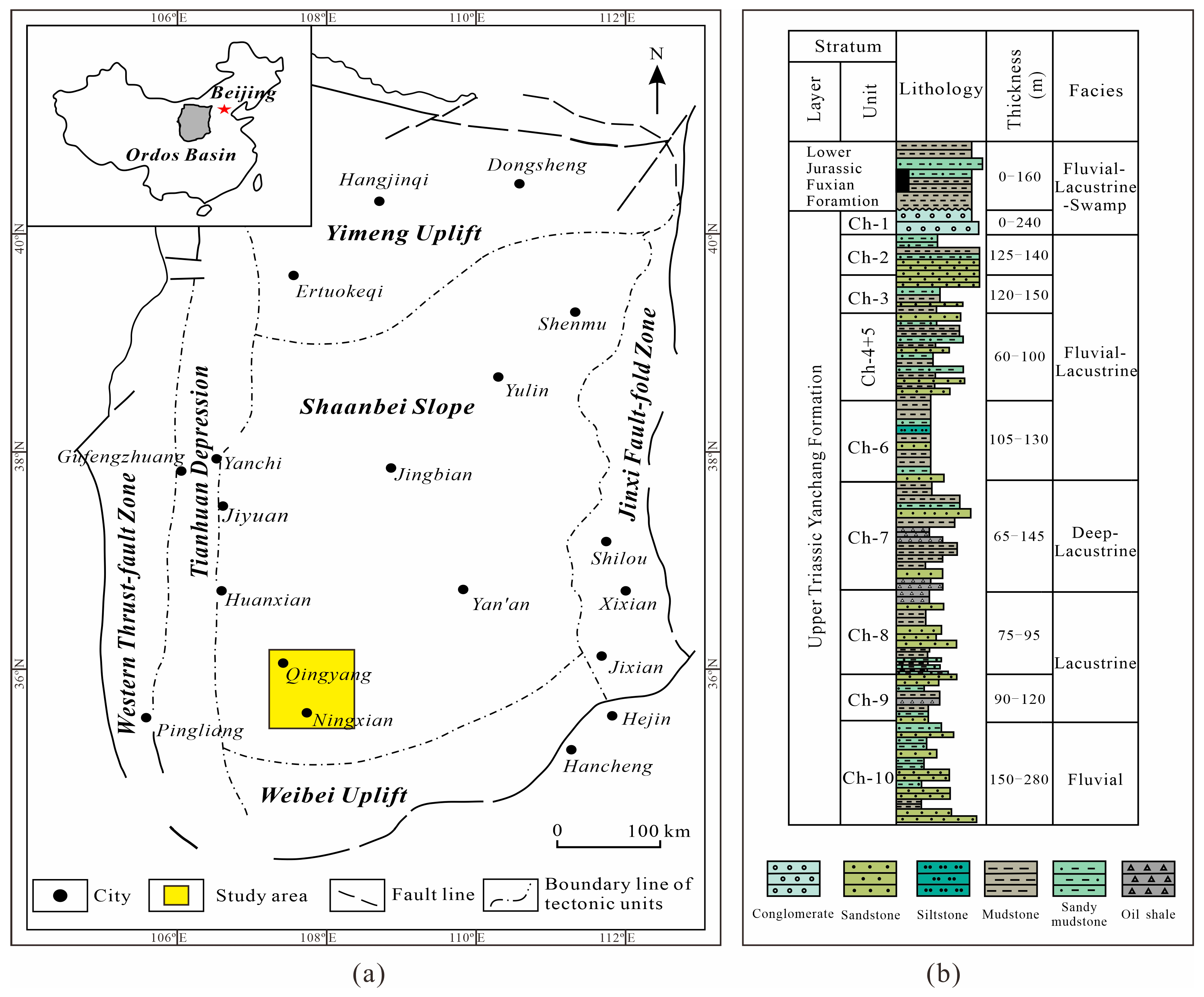
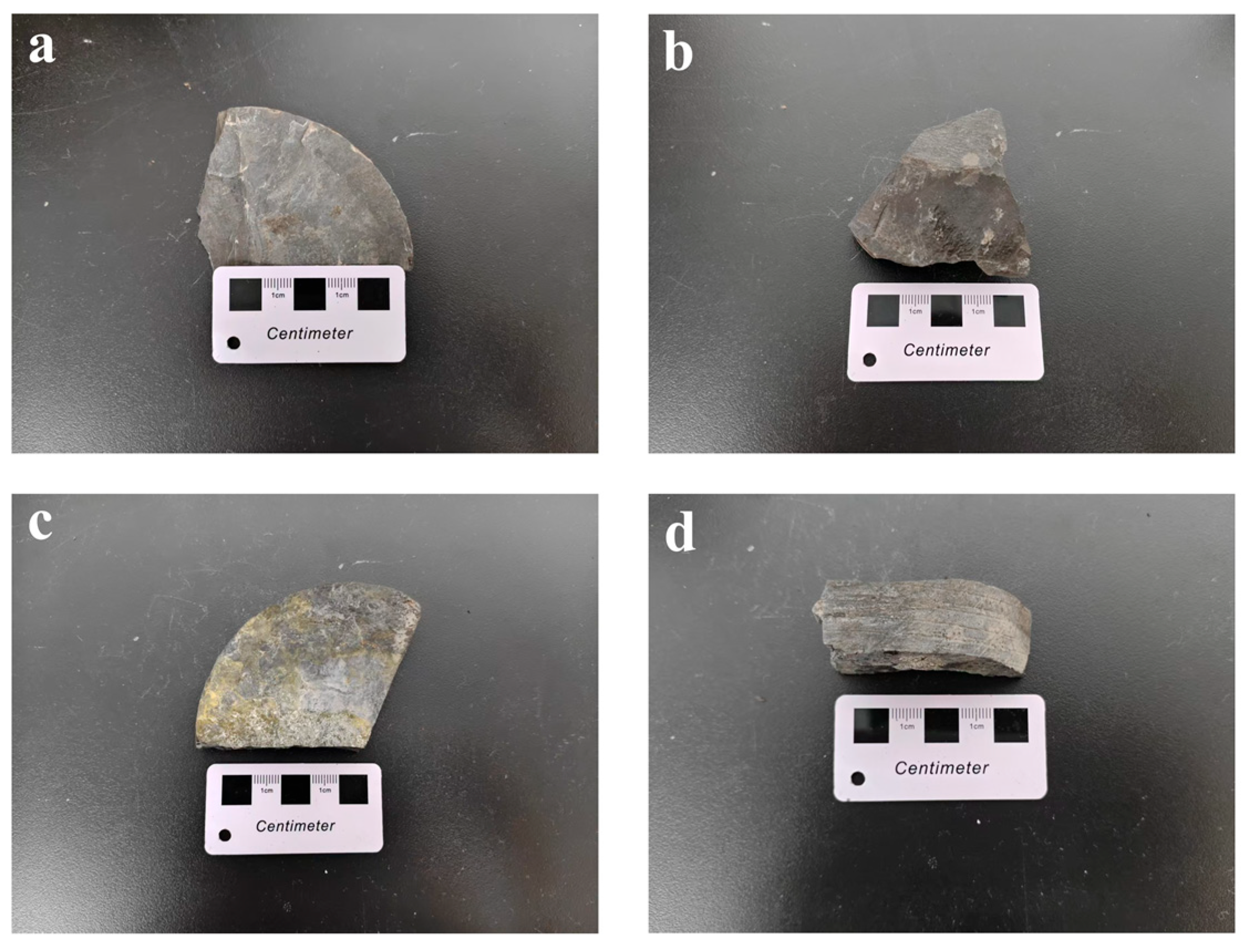
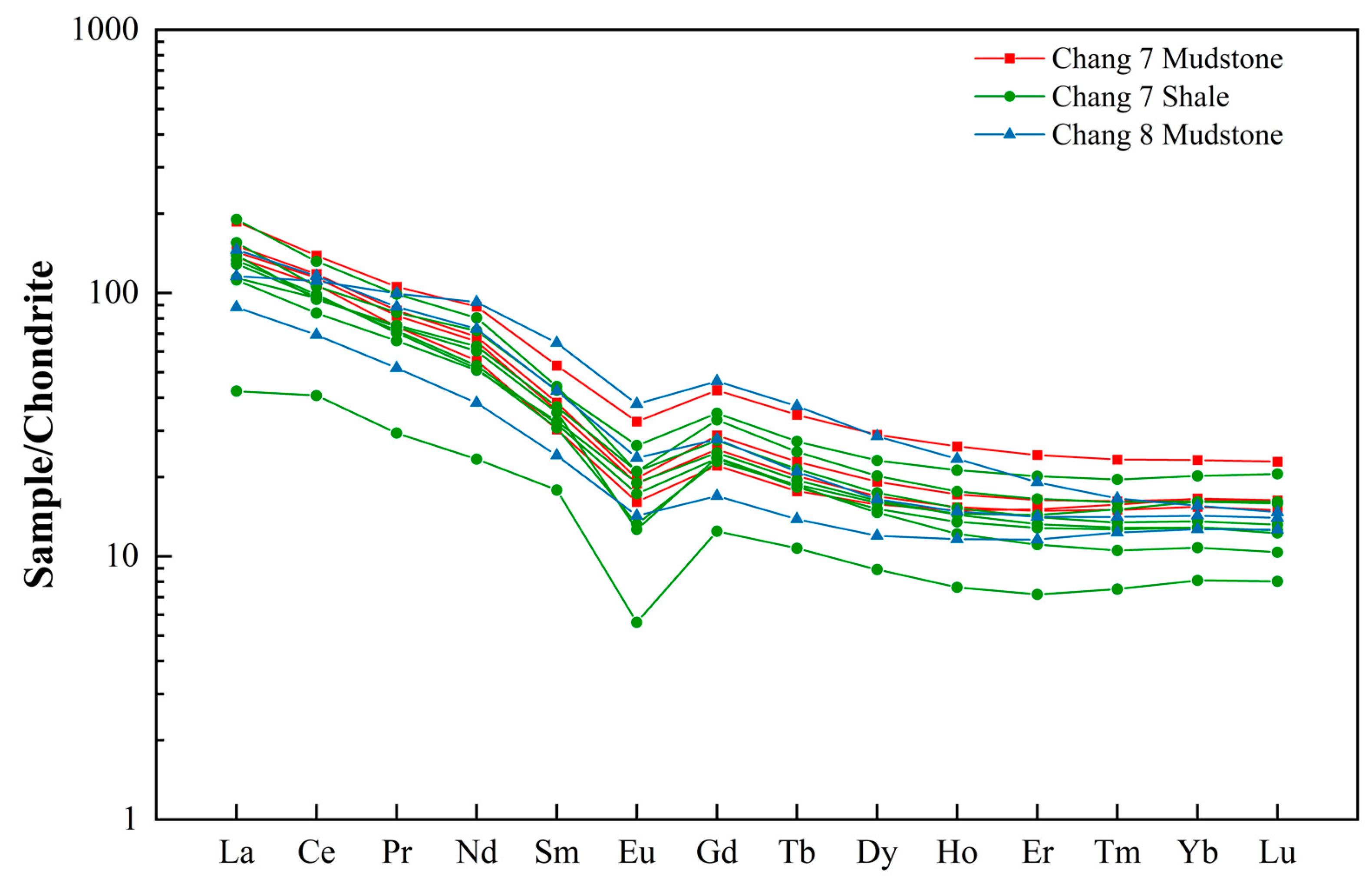

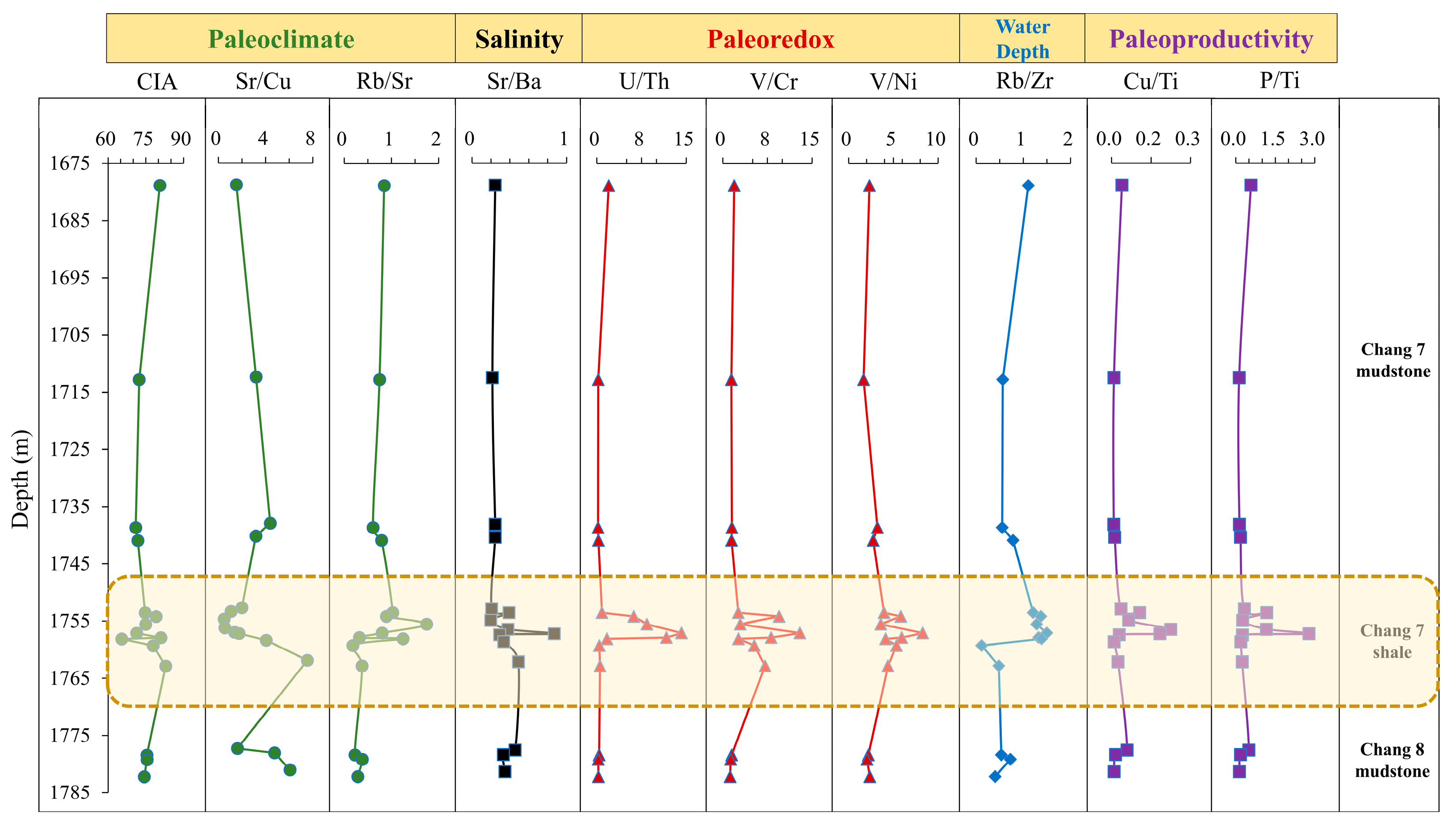
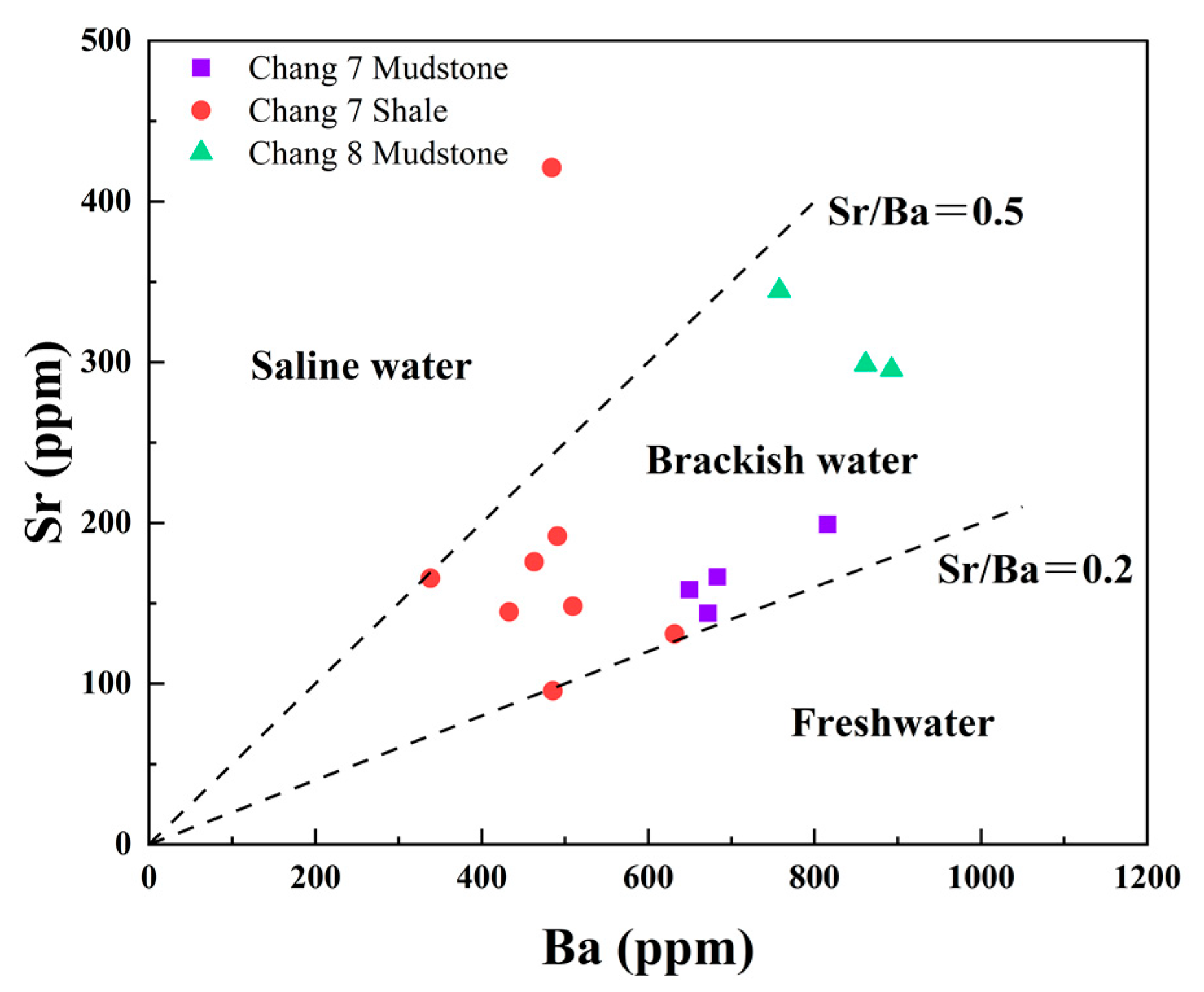
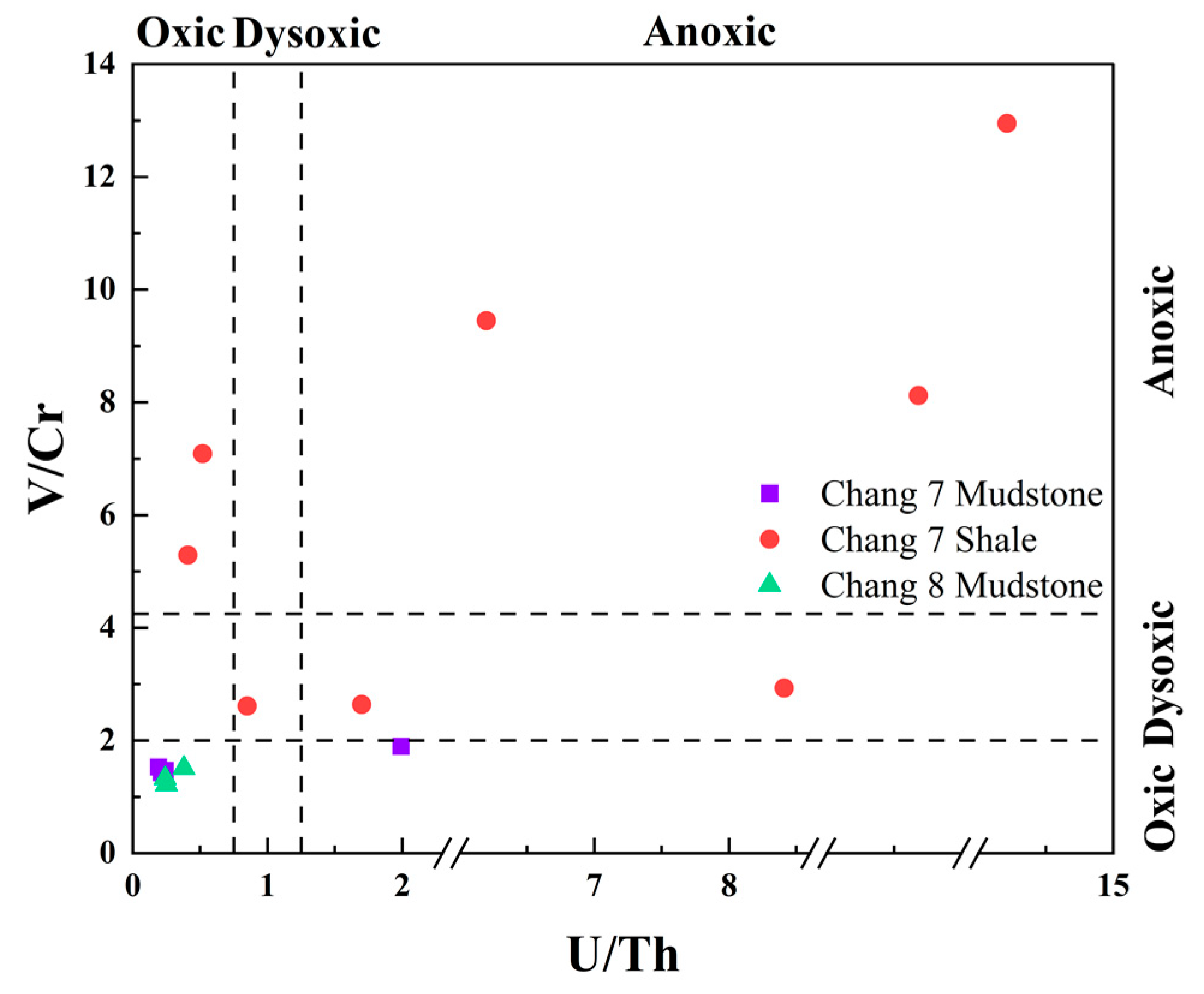


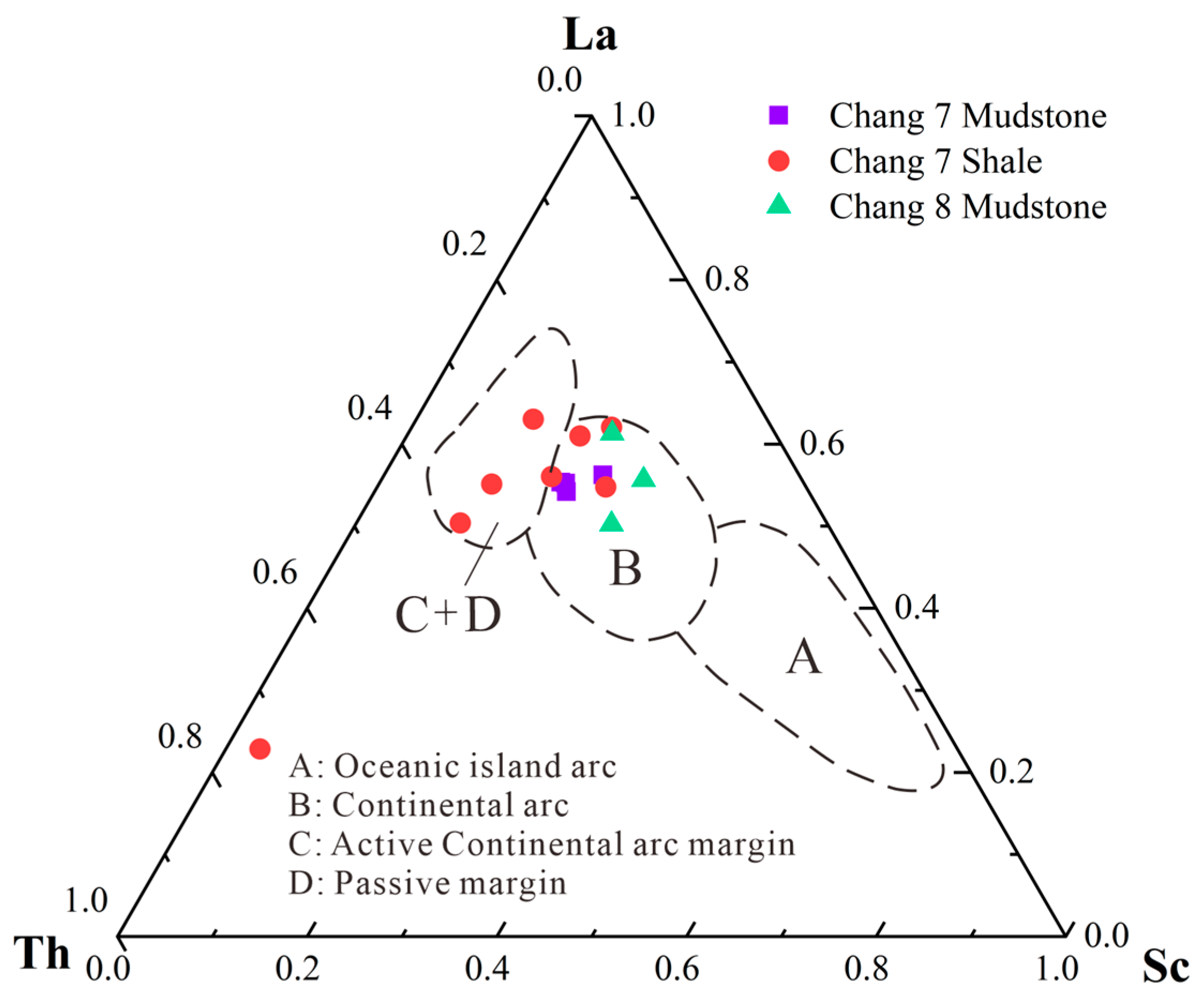
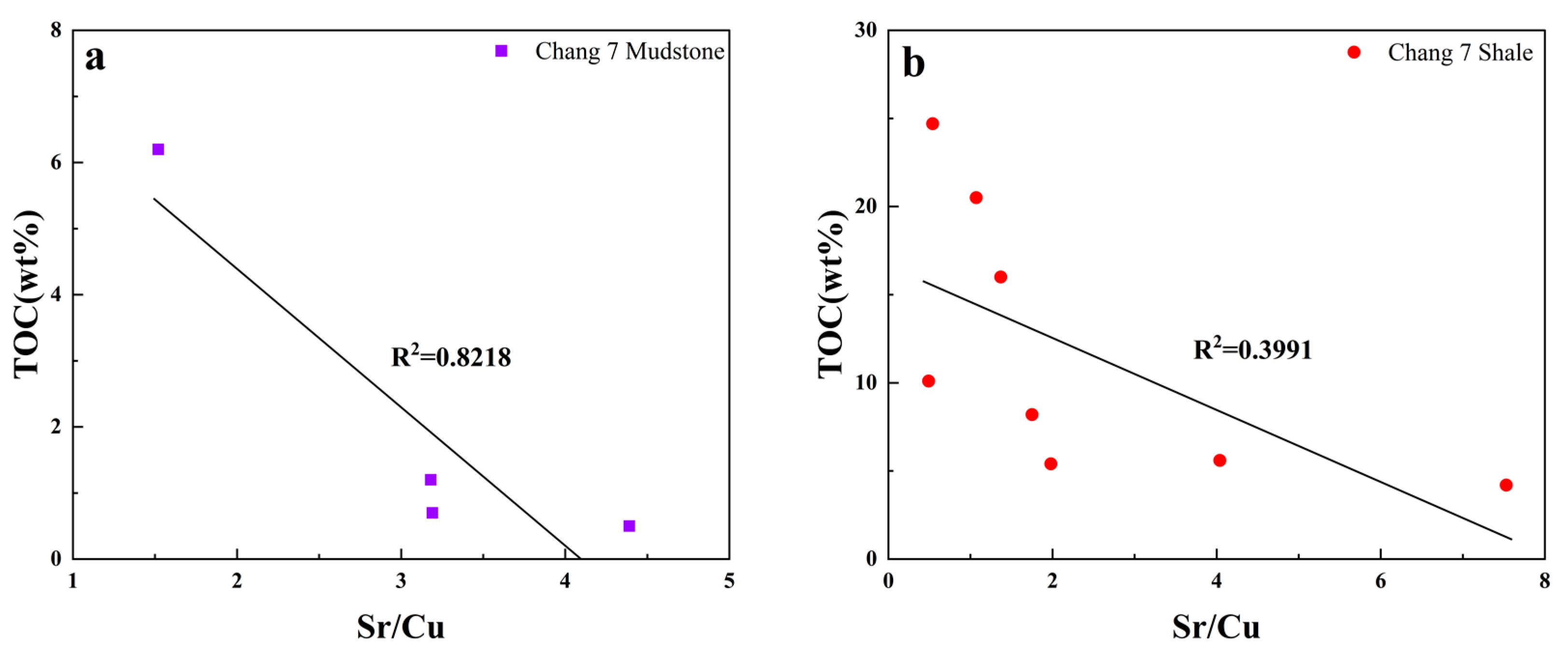
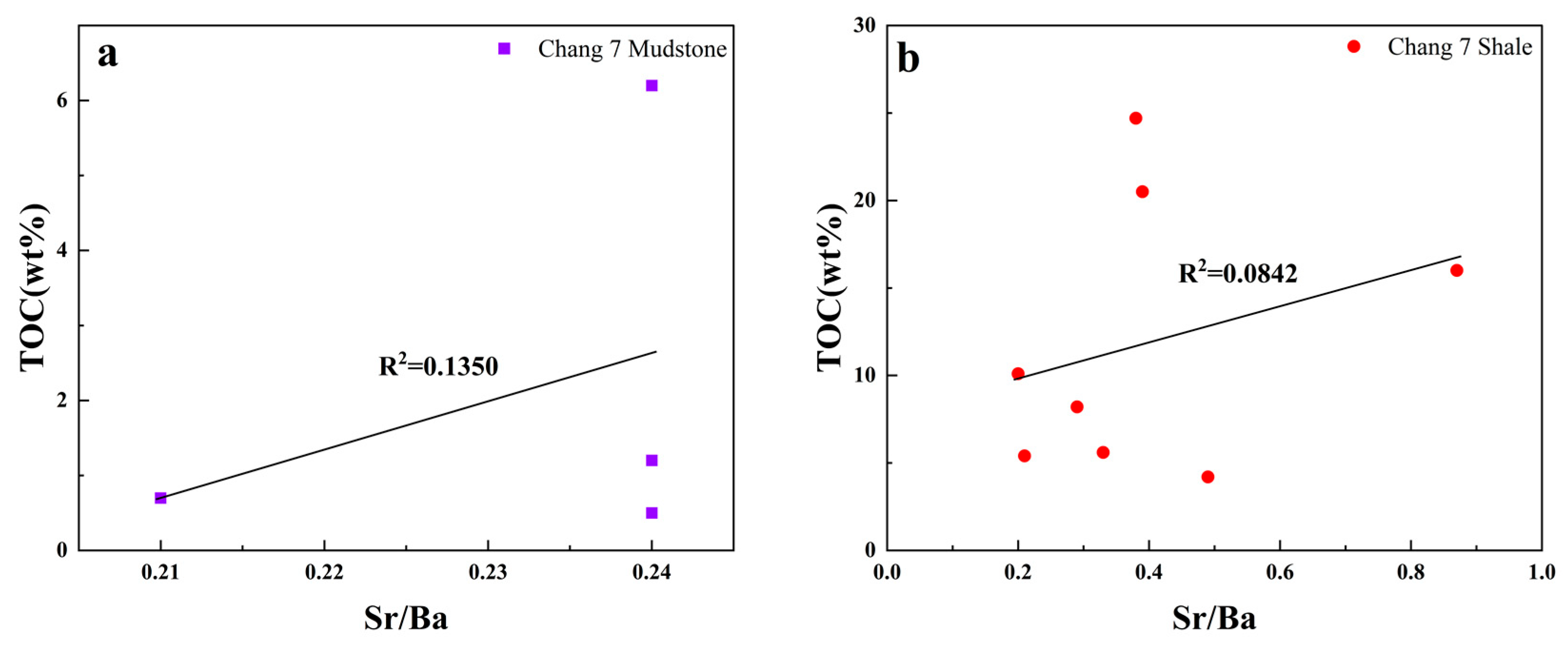
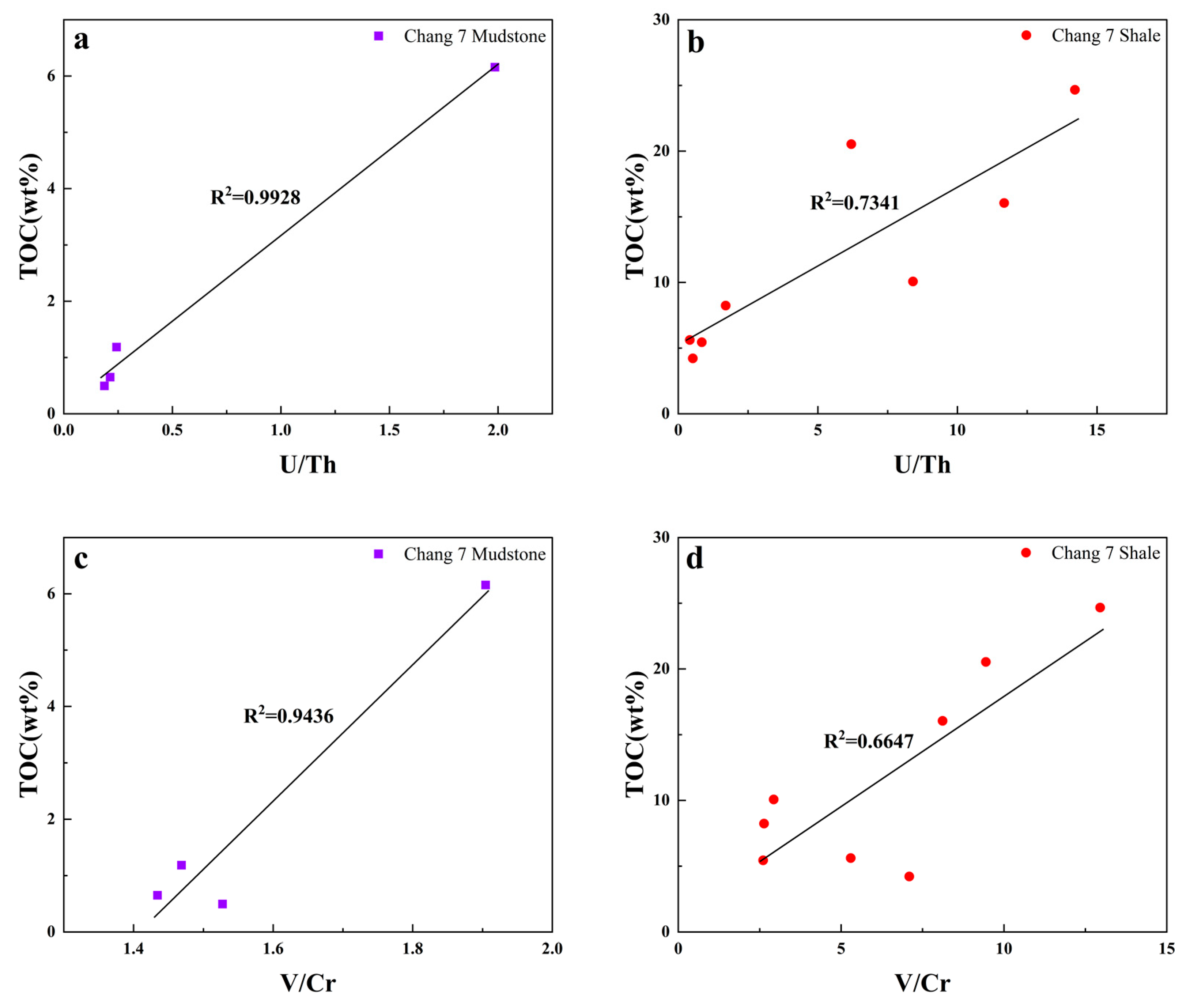
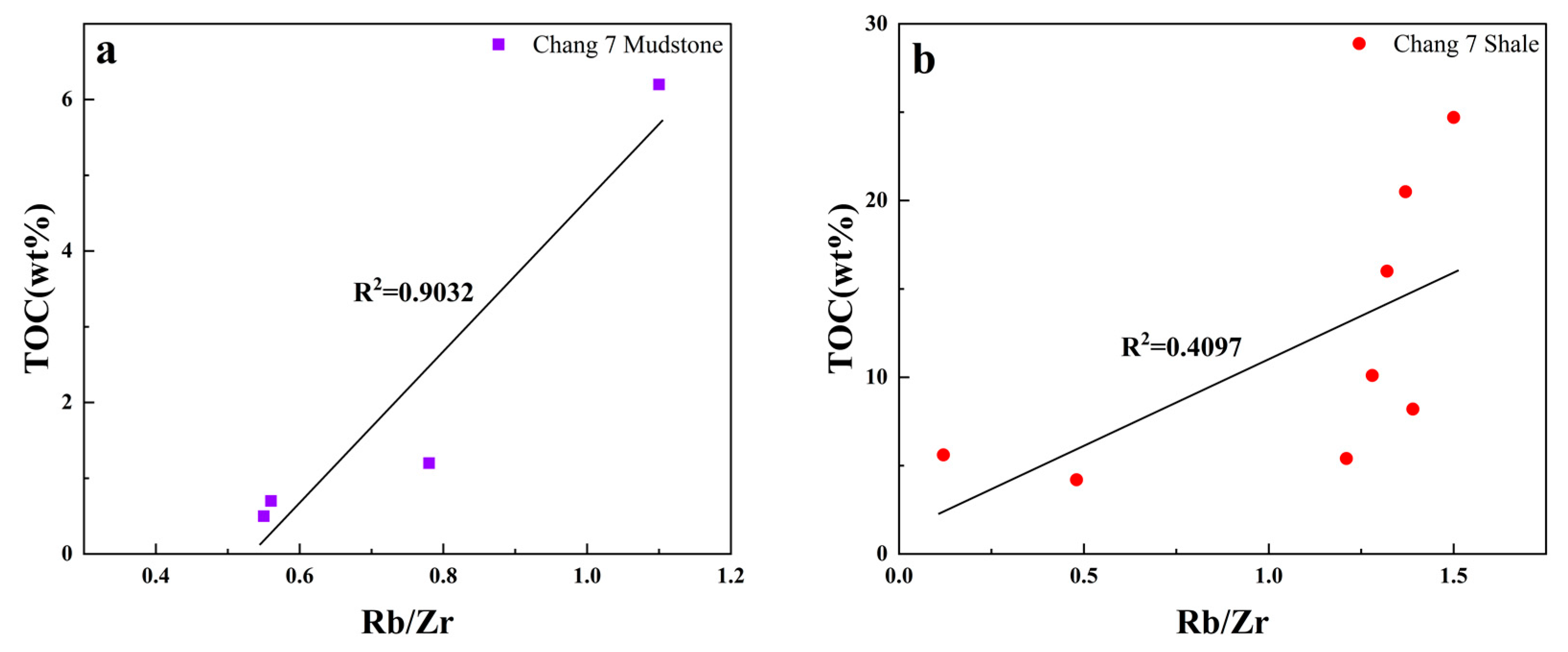

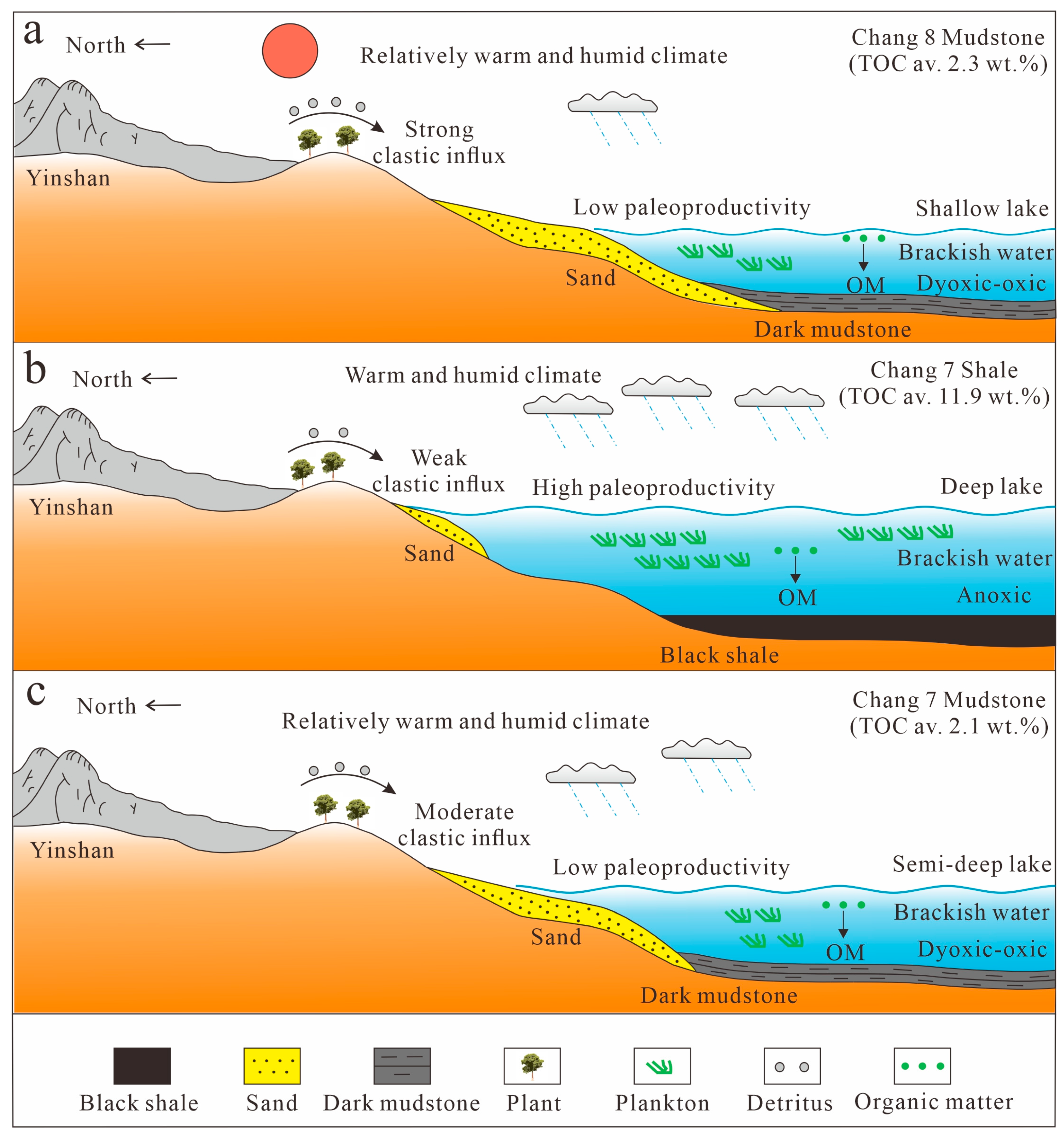
| Samples | Depth (m) | Unit | Lithology | SiO2 | TiO2 | Al2O3 | TFe2O3 | MnO | MgO | CaO | Na2O | K2O | P2O5 | LOI | TOC | P/Ti | CIA |
|---|---|---|---|---|---|---|---|---|---|---|---|---|---|---|---|---|---|
| N-1 | 1678.85 | Chang 7 | Dark mudstone | 42.93 | 0.56 | 17.03 | 14.17 | 0.03 | 1.73 | 0.96 | 0.91 | 3.73 | 0.45 | 18.06 | 6.16 | 0.57 | 80.60 |
| N-2 | 1712.80 | Chang 7 | Dark mudstone | 56.44 | 0.85 | 18.84 | 5.06 | 0.06 | 3.45 | 2.20 | 1.47 | 4.26 | 0.15 | 7.60 | 0.65 | 0.13 | 72.35 |
| N-3 | 1738.65 | Chang 7 | Dark mudstone | 57.81 | 0.79 | 17.51 | 5.13 | 0.06 | 3.04 | 2.12 | 1.71 | 3.82 | 0.15 | 7.96 | 0.50 | 0.14 | 71.01 |
| N-4 | 1740.90 | Chang 7 | Dark mudstone | 57.68 | 0.73 | 15.75 | 6.35 | 0.09 | 3.14 | 2.68 | 1.31 | 3.57 | 0.18 | 8.80 | 1.18 | 0.18 | 71.79 |
| N-5 | 1753.55 | Chang 7 | Black shale | 57.65 | 0.31 | 14.03 | 7.48 | 0.06 | 1.28 | 1.52 | 1.12 | 2.57 | 0.14 | 14.30 | 5.45 | 0.32 | 74.73 |
| N-6 | 1754.20 | Chang 7 | Black shale | 33.98 | 0.28 | 8.04 | 13.29 | 0.06 | 0.51 | 1.22 | 0.46 | 1.98 | 0.46 | 40.50 | 20.52 | 1.17 | 79.08 |
| N-7 | 1755.55 | Chang 7 | Black shale | 37.29 | 0.51 | 11.61 | 17.64 | 0.05 | 0.79 | 1.12 | 0.76 | 2.61 | 0.18 | 27.72 | 10.07 | 0.25 | 74.90 |
| N-8 | 1757.10 | Chang 7 | Black shale | 18.29 | 0.24 | 4.26 | 15.58 | 0.06 | 0.46 | 1.13 | 0.49 | 1.39 | 0.39 | 58.40 | 24.67 | 1.16 | 71.36 |
| N-9 | 1757.90 | Chang 7 | Black shale | 28.75 | 0.28 | 7.49 | 18.74 | 0.09 | 0.59 | 2.33 | 1.10 | 1.96 | 1.09 | 38.26 | 16.05 | 2.78 | 81.00 |
| N-10 | 1758.10 | Chang 7 | Black shale | 54.85 | 0.49 | 12.38 | 6.89 | 0.13 | 1.62 | 1.96 | 1.16 | 4.24 | 0.17 | 16.50 | 8.24 | 0.25 | 65.36 |
| N-11 | 1759.30 | Chang 7 | Black shale | 55.81 | 0.65 | 20.12 | 3.02 | 0.02 | 1.04 | 1.37 | 3.14 | 1.78 | 0.17 | 12.90 | 5.62 | 0.19 | 77.85 |
| N-12 | 1762.85 | Chang 7 | Black shale | 59.30 | 0.15 | 20.40 | 2.57 | 0.02 | 1.95 | 0.60 | 0.61 | 3.16 | 0.05 | 11.90 | 4.22 | 0.24 | 82.92 |
| N-13 | 1778.40 | Chang 8 | Dark mudstone | 55.39 | 0.61 | 16.19 | 9.56 | 0.21 | 2.49 | 1.65 | 1.50 | 3.53 | 0.42 | 8.58 | 2.15 | 0.49 | 75.41 |
| N-14 | 1779.20 | Chang 8 | Dark mudstone | 57.81 | 0.71 | 18.38 | 6.18 | 0.07 | 2.36 | 0.72 | 1.56 | 4.26 | 0.17 | 7.88 | 2.78 | 0.17 | 75.47 |
| N-15 | 1782.20 | Chang 8 | Dark mudstone | 60.30 | 0.89 | 17.68 | 6.21 | 0.05 | 2.60 | 0.74 | 2.25 | 3.68 | 0.17 | 5.94 | 1.85 | 0.14 | 74.34 |
| Samples | V | Cr | Co | Ni | Cu | Rb | Sr | Zr | Mo | Ba | Pb | Th | U | Sr/Cu | Rb/Sr | Sr/Ba | V/Ni | U/Th | V/Cr | Rb/Zr | Cu/Ti |
|---|---|---|---|---|---|---|---|---|---|---|---|---|---|---|---|---|---|---|---|---|---|
| N-1 | 203.06 | 106.63 | 41.08 | 87.71 | 130.93 | 168.25 | 199.06 | 152.43 | 76.49 | 815.66 | 50.94 | 21.34 | 42.36 | 1.52 | 0.85 | 0.24 | 2.32 | 1.99 | 1.90 | 1.10 | 0.039 |
| N-2 | 148.36 | 103.45 | 25.71 | 89.32 | 45.17 | 107.51 | 143.97 | 191.08 | 1.83 | 671.87 | 27.99 | 19.99 | 4.26 | 3.19 | 0.75 | 0.21 | 1.66 | 0.21 | 1.43 | 0.56 | 0.009 |
| N-3 | 131.62 | 86.18 | 20.04 | 41.01 | 37.92 | 101.45 | 166.44 | 183.38 | 1.12 | 682.98 | 28.98 | 20.16 | 3.77 | 4.39 | 0.61 | 0.24 | 3.21 | 0.19 | 1.53 | 0.55 | 0.008 |
| N-4 | 131.45 | 89.51 | 19.32 | 48.07 | 49.86 | 125.05 | 158.57 | 159.73 | 5.82 | 649.49 | 30.16 | 21.63 | 5.25 | 3.18 | 0.79 | 0.24 | 2.73 | 0.24 | 1.47 | 0.78 | 0.011 |
| N-5 | 103.56 | 39.74 | 18.05 | 26.23 | 66.12 | 134.16 | 130.90 | 111.23 | 34.13 | 631.88 | 37.68 | 31.68 | 26.79 | 1.98 | 1.02 | 0.21 | 3.95 | 0.85 | 2.61 | 1.21 | 0.036 |
| N-6 | 393.90 | 41.70 | 33.51 | 67.46 | 178.78 | 170.49 | 191.75 | 124.37 | 186.28 | 491.00 | 40.17 | 23.08 | 143.10 | 1.07 | 0.89 | 0.39 | 5.84 | 6.20 | 9.45 | 1.37 | 0.107 |
| N-7 | 223.52 | 76.30 | 30.16 | 62.43 | 196.83 | 166.47 | 95.51 | 129.84 | 140.27 | 485.61 | 30.26 | 13.38 | 112.51 | 0.49 | 1.74 | 0.20 | 3.58 | 8.41 | 2.93 | 1.28 | 0.064 |
| N-8 | 726.38 | 56.07 | 42.12 | 87.67 | 323.41 | 140.99 | 175.84 | 94.16 | 344.12 | 463.29 | 30.50 | 14.68 | 208.56 | 0.54 | 0.80 | 0.38 | 8.29 | 14.21 | 12.95 | 1.50 | 0.225 |
| N-9 | 437.16 | 53.85 | 37.10 | 73.75 | 307.85 | 134.29 | 420.97 | 101.45 | 211.34 | 484.09 | 53.37 | 13.07 | 152.57 | 1.37 | 0.32 | 0.87 | 5.93 | 11.68 | 8.12 | 1.32 | 0.183 |
| N-10 | 178.10 | 67.58 | 22.53 | 43.23 | 84.73 | 184.05 | 148.18 | 132.78 | 51.98 | 509.56 | 34.61 | 18.64 | 31.68 | 1.75 | 1.24 | 0.29 | 4.12 | 1.70 | 2.64 | 1.39 | 0.029 |
| N-11 | 60.03 | 11.34 | 9.80 | 11.26 | 35.81 | 26.11 | 144.66 | 219.90 | 13.64 | 433.11 | 33.43 | 21.18 | 8.74 | 4.04 | 0.18 | 0.33 | 5.33 | 0.41 | 5.29 | 0.12 | 0.009 |
| N-12 | 30.52 | 4.30 | 2.94 | 6.95 | 21.99 | 62.48 | 165.61 | 130.12 | 16.32 | 338.58 | 41.20 | 42.26 | 22.11 | 7.53 | 0.38 | 0.49 | 4.39 | 0.52 | 7.09 | 0.48 | 0.024 |
| N-13 | 121.27 | 80.36 | 17.25 | 55.09 | 213.97 | 77.29 | 344.49 | 144.44 | 1.05 | 757.98 | 27.98 | 10.78 | 4.09 | 1.61 | 0.22 | 0.45 | 2.20 | 0.38 | 1.51 | 0.54 | 0.059 |
| N-14 | 120.04 | 90.24 | 23.95 | 58.71 | 62.12 | 112.27 | 295.42 | 154.93 | 1.79 | 892.74 | 43.68 | 12.42 | 2.96 | 4.76 | 0.38 | 0.33 | 2.04 | 0.24 | 1.33 | 0.72 | 0.015 |
| N-15 | 120.10 | 98.60 | 22.14 | 50.99 | 49.30 | 85.38 | 298.66 | 213.03 | 1.28 | 861.46 | 27.16 | 12.68 | 3.17 | 6.06 | 0.29 | 0.35 | 2.36 | 0.25 | 1.22 | 0.40 | 0.009 |
| Samples | La | Ce | Pr | Nd | Sm | Eu | Gd | Tb | Dy | Ho | Er | Tm | Yb | Lu | δCe | δEu | ∑REE | LREE | HREE | L/H | (La/Yb)N | La/Yb |
|---|---|---|---|---|---|---|---|---|---|---|---|---|---|---|---|---|---|---|---|---|---|---|
| N-1 | 58.00 | 112.15 | 12.90 | 53.28 | 10.34 | 2.39 | 11.08 | 1.63 | 9.33 | 1.88 | 5.09 | 0.76 | 4.85 | 0.74 | 1.0 | 0.7 | 284.4 | 249.1 | 35.4 | 7.0 | 8.1 | 11.9 |
| N-2 | 42.38 | 86.89 | 9.09 | 33.22 | 5.92 | 1.18 | 5.72 | 0.84 | 5.07 | 1.07 | 3.16 | 0.51 | 3.46 | 0.53 | 1.1 | 0.6 | 199.1 | 178.7 | 20.4 | 8.8 | 8.2 | 12.2 |
| N-3 | 44.34 | 92.38 | 10.02 | 39.31 | 6.96 | 1.39 | 6.61 | 0.96 | 5.45 | 1.10 | 3.13 | 0.49 | 3.22 | 0.48 | 1.1 | 0.6 | 215.8 | 194.4 | 21.4 | 9.1 | 9.3 | 13.8 |
| N-4 | 46.82 | 95.47 | 10.46 | 40.95 | 7.47 | 1.45 | 7.46 | 1.09 | 6.18 | 1.23 | 3.44 | 0.52 | 3.44 | 0.51 | 1.0 | 0.6 | 226.5 | 202.6 | 23.9 | 8.5 | 9.2 | 13.6 |
| N-5 | 41.28 | 79.80 | 8.62 | 31.02 | 5.99 | 0.97 | 5.93 | 0.89 | 5.15 | 1.04 | 3.02 | 0.49 | 3.37 | 0.52 | 1.0 | 0.5 | 188.1 | 167.7 | 20.4 | 8.2 | 8.3 | 12.2 |
| N-6 | 59.01 | 106.65 | 12.08 | 48.34 | 8.61 | 1.54 | 8.53 | 1.18 | 6.50 | 1.27 | 3.47 | 0.52 | 3.38 | 0.51 | 1.0 | 0.5 | 261.6 | 236.2 | 25.4 | 9.3 | 11.8 | 17.5 |
| N-7 | 34.71 | 67.83 | 8.02 | 30.55 | 6.36 | 1.40 | 6.41 | 0.92 | 5.24 | 1.03 | 2.78 | 0.42 | 2.69 | 0.39 | 1.0 | 0.7 | 168.7 | 148.9 | 19.9 | 7.5 | 8.7 | 12.9 |
| N-8 | 43.17 | 76.38 | 9.20 | 37.66 | 7.21 | 1.54 | 7.14 | 1.02 | 5.61 | 1.10 | 2.96 | 0.44 | 2.85 | 0.42 | 0.9 | 0.7 | 196.7 | 175.2 | 21.5 | 8.1 | 10.2 | 15.2 |
| N-9 | 48.11 | 85.72 | 10.28 | 43.17 | 8.33 | 1.94 | 9.04 | 1.30 | 7.44 | 1.52 | 4.23 | 0.63 | 4.22 | 0.66 | 0.9 | 0.7 | 226.6 | 197.6 | 29.0 | 6.8 | 7.7 | 11.4 |
| N-10 | 39.88 | 78.22 | 8.77 | 31.82 | 6.21 | 1.27 | 6.10 | 0.87 | 4.88 | 0.97 | 2.70 | 0.41 | 2.69 | 0.40 | 1.0 | 0.6 | 185.2 | 166.2 | 19.0 | 8.7 | 10.0 | 14.8 |
| N-11 | 35.39 | 77.35 | 9.09 | 36.13 | 6.87 | 0.93 | 6.14 | 0.88 | 4.72 | 0.87 | 2.33 | 0.34 | 2.25 | 0.33 | 1.0 | 0.4 | 183.6 | 165.8 | 17.9 | 9.3 | 10.6 | 15.7 |
| N-12 | 13.14 | 32.99 | 3.59 | 14.02 | 3.48 | 0.41 | 3.22 | 0.51 | 2.87 | 0.55 | 1.51 | 0.24 | 1.69 | 0.26 | 1.2 | 0.4 | 78.5 | 67.6 | 10.8 | 6.2 | 5.2 | 7.8 |
| N-13 | 35.92 | 89.83 | 12.15 | 55.37 | 12.61 | 2.79 | 11.97 | 1.76 | 9.20 | 1.68 | 4.02 | 0.54 | 3.25 | 0.47 | 1.0 | 0.7 | 241.6 | 208.7 | 32.9 | 6.3 | 7.4 | 11.0 |
| N-14 | 27.36 | 56.03 | 6.33 | 22.94 | 4.71 | 1.05 | 4.39 | 0.66 | 3.85 | 0.84 | 2.43 | 0.40 | 2.65 | 0.41 | 1.0 | 0.7 | 134.0 | 118.4 | 15.6 | 7.6 | 7.0 | 10.3 |
| N-15 | 45.25 | 93.92 | 10.82 | 43.85 | 8.28 | 1.74 | 7.21 | 0.99 | 5.30 | 1.06 | 2.97 | 0.46 | 2.99 | 0.45 | 1.0 | 0.7 | 225.3 | 203.9 | 21.4 | 9.5 | 10.2 | 15.2 |
Disclaimer/Publisher’s Note: The statements, opinions and data contained in all publications are solely those of the individual author(s) and contributor(s) and not of MDPI and/or the editor(s). MDPI and/or the editor(s) disclaim responsibility for any injury to people or property resulting from any ideas, methods, instructions or products referred to in the content. |
© 2025 by the authors. Licensee MDPI, Basel, Switzerland. This article is an open access article distributed under the terms and conditions of the Creative Commons Attribution (CC BY) license (https://creativecommons.org/licenses/by/4.0/).
Share and Cite
Wang, Z.; Cheng, H.; Wang, Y. Differential Geochemical Features of Lacustrine Shale and Mudstone from Triassic Yanchang Formation, Ordos Basin, China: Insights into Their Sedimentary Environments and Organic Matter Enrichment. Minerals 2025, 15, 656. https://doi.org/10.3390/min15060656
Wang Z, Cheng H, Wang Y. Differential Geochemical Features of Lacustrine Shale and Mudstone from Triassic Yanchang Formation, Ordos Basin, China: Insights into Their Sedimentary Environments and Organic Matter Enrichment. Minerals. 2025; 15(6):656. https://doi.org/10.3390/min15060656
Chicago/Turabian StyleWang, Ziming, Hongfei Cheng, and Yang Wang. 2025. "Differential Geochemical Features of Lacustrine Shale and Mudstone from Triassic Yanchang Formation, Ordos Basin, China: Insights into Their Sedimentary Environments and Organic Matter Enrichment" Minerals 15, no. 6: 656. https://doi.org/10.3390/min15060656
APA StyleWang, Z., Cheng, H., & Wang, Y. (2025). Differential Geochemical Features of Lacustrine Shale and Mudstone from Triassic Yanchang Formation, Ordos Basin, China: Insights into Their Sedimentary Environments and Organic Matter Enrichment. Minerals, 15(6), 656. https://doi.org/10.3390/min15060656








